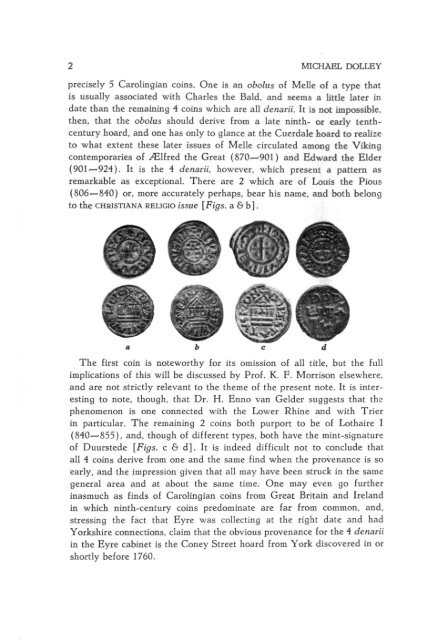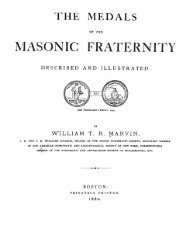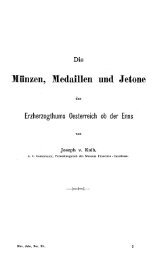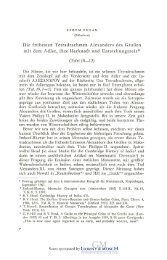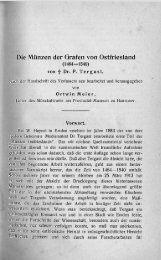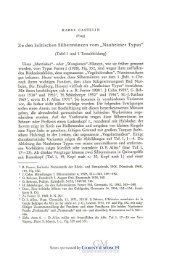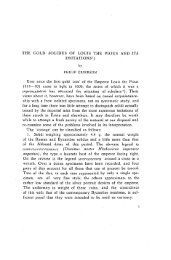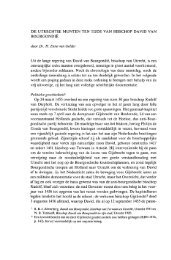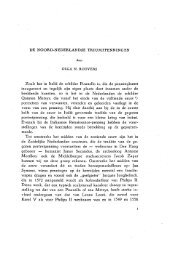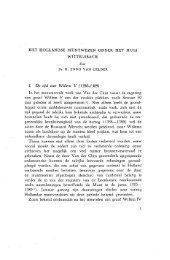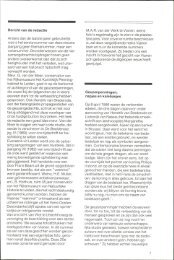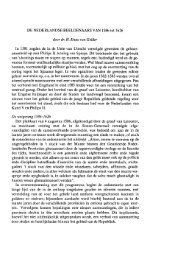New light on the pre-1760 Coney Street (York) find of coins of the ...
New light on the pre-1760 Coney Street (York) find of coins of the ...
New light on the pre-1760 Coney Street (York) find of coins of the ...
You also want an ePaper? Increase the reach of your titles
YUMPU automatically turns print PDFs into web optimized ePapers that Google loves.
2 MICHAEL DOLLEY<br />
<strong>pre</strong>cisely 5 Carolingian <strong>coins</strong>. One is an obolus <strong>of</strong> Melle <strong>of</strong> a type that<br />
is usually associated with Charles <strong>the</strong> Bald, and seems a little later in<br />
date than <strong>the</strong> remaining 4 <strong>coins</strong> which are all denarii. It is not impossible,<br />
<strong>the</strong>n, that <strong>the</strong> obolus should derive from a late ninth- or early tenthcentury<br />
hoard, and <strong>on</strong>e has <strong>on</strong>ly to glance at <strong>the</strong> Cuerdale hoard to realize<br />
to what extent <strong>the</strong>se later issues <strong>of</strong> Melle circulated am<strong>on</strong>g <strong>the</strong> Viking<br />
c<strong>on</strong>temporaries <strong>of</strong> ^lfred <strong>the</strong> Great (870-901) and Edward <strong>the</strong> Elder<br />
(901-924). It is <strong>the</strong> 4 denarii, however, which <strong>pre</strong>sent a pattern as<br />
remarkable as excepti<strong>on</strong>al. There are 2 which are <strong>of</strong> Louis <strong>the</strong> Pious<br />
(806-840) or, more accurately perhaps, bear his name, and both bel<strong>on</strong>g<br />
to <strong>the</strong> CHRISTIANA RELIGIO issue [Figs. a & b].<br />
The first coin is noteworthy for its omissi<strong>on</strong> <strong>of</strong> all title, but <strong>the</strong> full<br />
implicati<strong>on</strong>s <strong>of</strong> this will be discussed by Pr<strong>of</strong>. K. F. Morris<strong>on</strong> elsewhere,<br />
and are not strictly relevant to <strong>the</strong> <strong>the</strong>me <strong>of</strong> <strong>the</strong> <strong>pre</strong>sent note. It is interesting<br />
to note, though, that Dr. H. Enno van Gelder suggests that <strong>the</strong><br />
phenomen<strong>on</strong> is <strong>on</strong>e c<strong>on</strong>nected with <strong>the</strong> Lower Rhine and with Trier<br />
in particular. The remaining 2 <strong>coins</strong> both purport to be <strong>of</strong> Lothaire I<br />
(840-855), and, though <strong>of</strong> different types, both have <strong>the</strong> mint-signature<br />
<strong>of</strong> Duurstede [Figs. c 6 d]. It is indeed difficult not to c<strong>on</strong>clude that<br />
all 4 <strong>coins</strong> derive from <strong>on</strong>e and <strong>the</strong> same <strong>find</strong> when <strong>the</strong> provenance is so<br />
early, and <strong>the</strong> im<strong>pre</strong>ssi<strong>on</strong> given that all may have been struck in <strong>the</strong> same<br />
general area and at about <strong>the</strong> same time. One may even go fur<strong>the</strong>r<br />
inasmuch as <strong>find</strong>s <strong>of</strong> Carolingian <strong>coins</strong> from Great Britain and Ireland<br />
in which ninth-century <strong>coins</strong> <strong>pre</strong>dominate are far from comm<strong>on</strong>, and,<br />
stressing <strong>the</strong> fact that Eyre was collecting at <strong>the</strong> right date and had<br />
<strong>York</strong>shire c<strong>on</strong>necti<strong>on</strong>s, claim that <strong>the</strong> obvious provenance for <strong>the</strong> 4 denarii<br />
in <strong>the</strong> Eyre cabinet is <strong>the</strong> C<strong>on</strong>ey <strong>Street</strong> hoard from <strong>York</strong> discovered in or<br />
shortly before <strong>1760</strong>.


